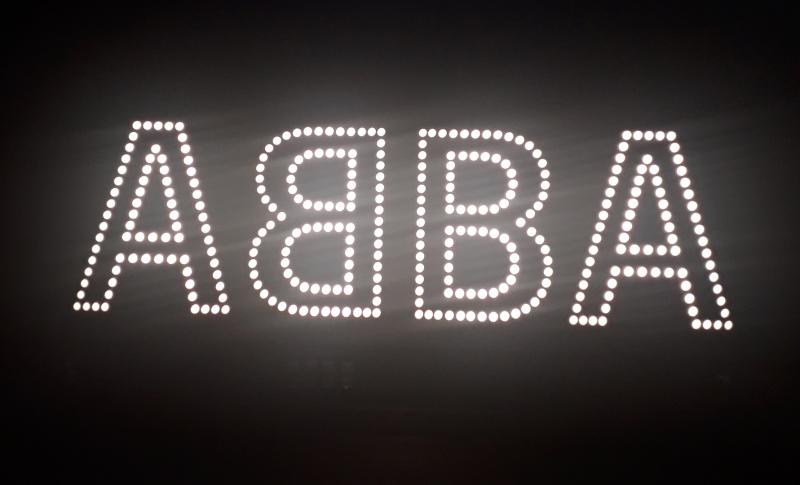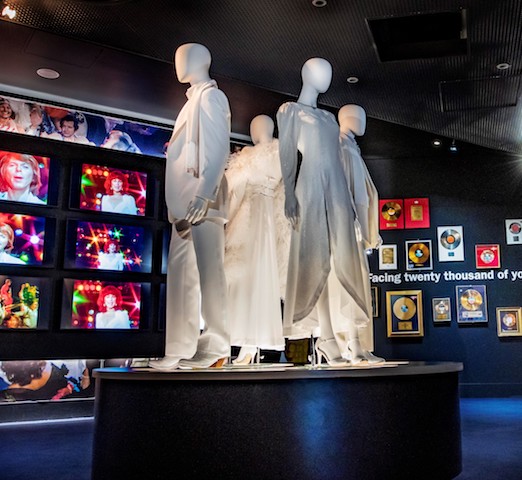ABBA: Super Troupers The Exhibition, O2 - one for the supergroup's completists | reviews, news & interviews
ABBA: Super Troupers The Exhibition, O2 - one for the supergroup's completists
ABBA: Super Troupers The Exhibition, O2 - one for the supergroup's completists
Some interesting nuggets unearthed

Abba fans can already have an immersive dining/dancing/singing experience at the O2 in Mamma Mia! The Party, and now, almost as a companion piece, is ABBA: Super Troupers The Exhibition, a show that sets out tell “the story of the band, their music and the era they defined”.
That's a pretty tall order and I'm not sure – even as a dedicated fan – that Abba defined an era, but on the other two points this multimedia exhibition makes a decent go of it as it describes the group's history from first meeting to eventual break-up, and beyond.
The four – Agnetha Fältskog, Björn Ulvaeus, Benny Andersson and Anni-Frid (Frida) Lyngstad – became an overnight international sensation when they won the Eurovision Song Contest in 1974. What may be new to many people here is details of their earlier careers – Agnetha and Frida were both established artists in Sweden, the former a singer-songwriter of some repute – and in the early days they worked with other artists such as Neil Sedaka, who helped write the English lyrics for “Ring, Ring”.
 The audio guide for this show is a must, as the written material on walls and stands is in tiny print and would be impossible read for most people unless they are up close. But the audio guides contain music, background information and interviews with the band and their associates, some of them commissioned especially.
The audio guide for this show is a must, as the written material on walls and stands is in tiny print and would be impossible read for most people unless they are up close. But the audio guides contain music, background information and interviews with the band and their associates, some of them commissioned especially.
The interviews throw up some interesting snippets, including how the reversed second B in the ABBA branding came about (Benny, the joker of the group, was horsing around at a press shoot), and how Benny and Björn's first meeting – “life-changing” the latter calls it – was because their cars had to stop to pass on a narrow road to a festival. They said hello, met for a drink with friends later, discovered a mutual love of The Beatles and it went from there.
Many items are more memorabilia than artefacts – Björn's school report (he was a good student), copies of costumes they wore (pictured above, the originals are in ABBA The Museum in Stockholm) and a wall of gold and platinum discs. Using a politics and news timeline in each room that sets their career in context, the exhibition tries to give some historical heft to the group that they didn't have, despite their many achievements.
But the room with documentary footage of Abba relaxing at their holiday homes on a small island, as well as a large selection of family photographs from that time, is a fascinating glimpse of their private selves. They attest to the fact that this supergroup – multi-millionaires in their thirties thanks to records such as “Dancing Queen” reaching No 1 in 19 countries – were at heart, “normal” people going about their daily lives unhindered by fame.
Part of the reason for this was that the group toured for a total of only six months in their 10 years recording together. Not for them the excesses of drugs and sex and rock 'n' roll on the road – they were parents to young children, whether together or with previous partners, and wanted to be back in Sweden whenever possible.
The music is, of course, sublimely good, and the exhibition shows Abba's progression from glam to pop (or Happy-Pop as one German television station called it) to disco, and there's footage of Abba's Eurovision win at Brighton Dome in 1974 with “Waterloo”. A must for Abba completists, but perhaps not for the casual music fan.
- ABBA: Super Troupers The Exhibition at the O2, London until 31 August 2020
The future of Arts Journalism
You can stop theartsdesk.com closing!
We urgently need financing to survive. Our fundraising drive has thus far raised £49,000 but we need to reach £100,000 or we will be forced to close. Please contribute here: https://gofund.me/c3f6033d
And if you can forward this information to anyone who might assist, we’d be grateful.

Subscribe to theartsdesk.com
Thank you for continuing to read our work on theartsdesk.com. For unlimited access to every article in its entirety, including our archive of more than 15,000 pieces, we're asking for £5 per month or £40 per year. We feel it's a very good deal, and hope you do too.
To take a subscription now simply click here.
And if you're looking for that extra gift for a friend or family member, why not treat them to a theartsdesk.com gift subscription?
more New music
 Yazmin Lacey confirms her place in a vital soul movement with 'Teal Dreams'
Intimacy and rich poetry on UK soul star's second LP
Yazmin Lacey confirms her place in a vital soul movement with 'Teal Dreams'
Intimacy and rich poetry on UK soul star's second LP
 Solar Eyes, Hare & Hounds, Birmingham review - local lads lay down some new tunes for a home crowd
Psychedelic indie dance music marinated in swirling dry ice
Solar Eyes, Hare & Hounds, Birmingham review - local lads lay down some new tunes for a home crowd
Psychedelic indie dance music marinated in swirling dry ice
 The Lemonheads' 'Love Chant' is a fine return to form
Evan Dando finally gets back in the saddle with an album of new tunes
The Lemonheads' 'Love Chant' is a fine return to form
Evan Dando finally gets back in the saddle with an album of new tunes
 Music Reissues Weekly: Evie Sands - I Can’t Let Go
Diligent, treasure-packed tribute to one of Sixties’ America’s great vocal stylists
Music Reissues Weekly: Evie Sands - I Can’t Let Go
Diligent, treasure-packed tribute to one of Sixties’ America’s great vocal stylists
 'Deadbeat': Tame Impala's downbeat rave-inspired latest
Fifth album from Australian project grooves but falls flat
'Deadbeat': Tame Impala's downbeat rave-inspired latest
Fifth album from Australian project grooves but falls flat
 Heartbreak and soaring beauty on Chrissie Hynde & Pals' Duets Special
The great Pretender at her most romantic and on the form of her life
Heartbreak and soaring beauty on Chrissie Hynde & Pals' Duets Special
The great Pretender at her most romantic and on the form of her life
 The Last Dinner Party's 'From the Pyre' is as enjoyable as it is over-the-top
Musically sophisticated five-piece ramp up the excesses but remain contagiously pop
The Last Dinner Party's 'From the Pyre' is as enjoyable as it is over-the-top
Musically sophisticated five-piece ramp up the excesses but remain contagiously pop
 Moroccan Gnawa comes to Manhattan with 'Saha Gnawa'
Trance and tradition meet Afrofuturism in Manhattan
Moroccan Gnawa comes to Manhattan with 'Saha Gnawa'
Trance and tradition meet Afrofuturism in Manhattan
 Soulwax’s 'All Systems Are Lying' lays down some tasty yet gritty electro-pop
Belgian dancefloor veterans return to the fray with a dark, pop-orientated sound
Soulwax’s 'All Systems Are Lying' lays down some tasty yet gritty electro-pop
Belgian dancefloor veterans return to the fray with a dark, pop-orientated sound
 Music Reissues Weekly: Marc and the Mambas - Three Black Nights Of Little Black Bites
When Marc Almond took time out from Soft Cell
Music Reissues Weekly: Marc and the Mambas - Three Black Nights Of Little Black Bites
When Marc Almond took time out from Soft Cell
 Album: Mobb Deep - Infinite
A solid tribute to a legendary history
Album: Mobb Deep - Infinite
A solid tribute to a legendary history
 Album: Boz Scaggs - Detour
Smooth and soulful standards from an old pro
Album: Boz Scaggs - Detour
Smooth and soulful standards from an old pro

Add comment